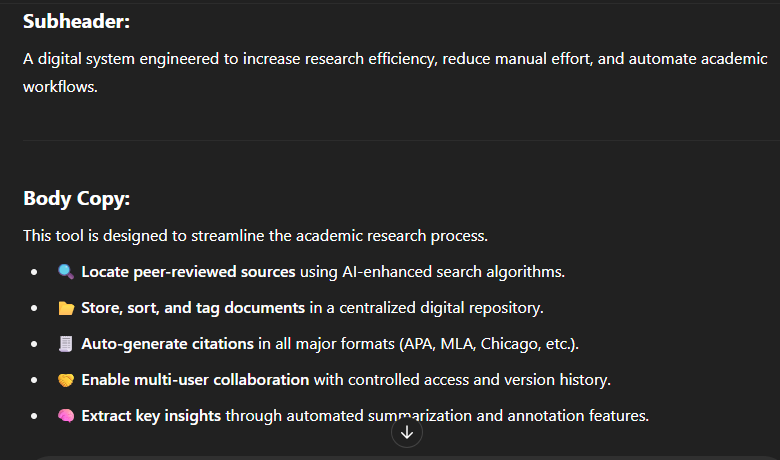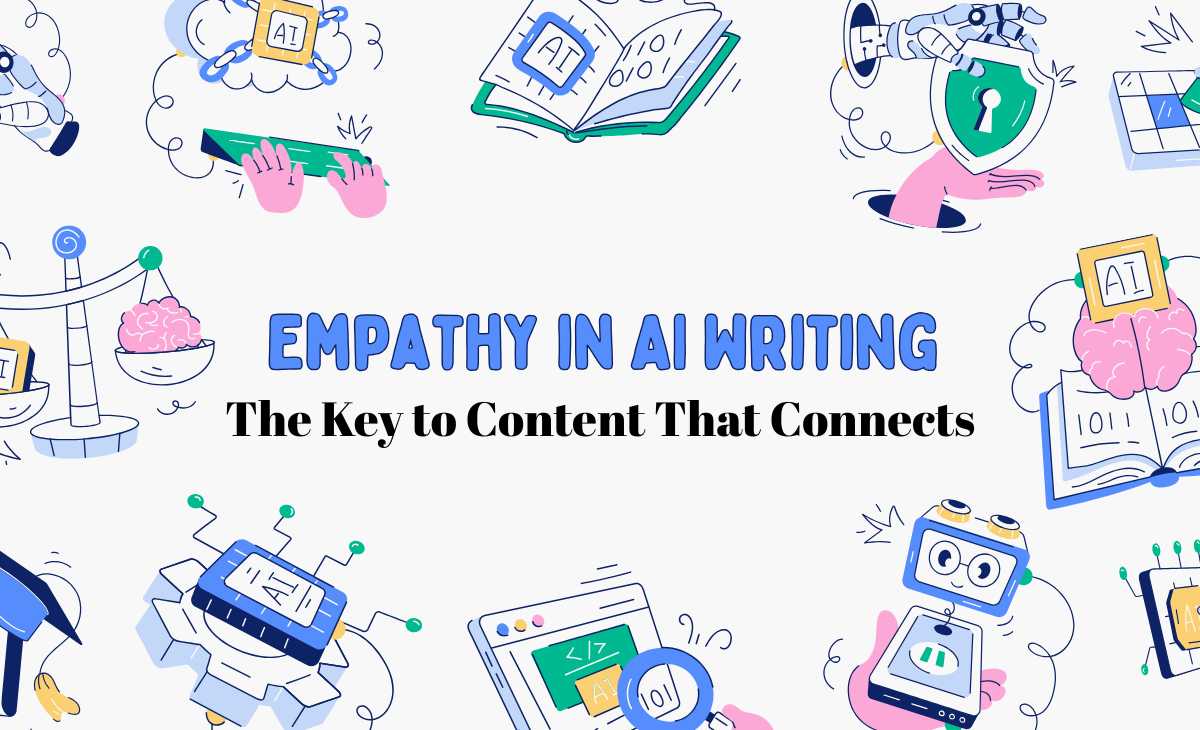Imagine that you are a student struggling with your research. You have multiple deadlines and also need to devote a certain amount of time to your assignments. In a moment of panic like this, would you choose a product that speaks only in AI-driven technicalities, or would you seek something with a bit of empathy in AI writing?
The answer is obvious and simple, you would have gone for a product that understands your situation. This is also the reason we still have an upper hand over AI: we know how to feel things, and AI doesn’t.
If you were a business trying to sell a product to a student like this, your marketing campaign would have been more about the anxiety of research, something AI will never understand.
AI doesn’t have the fear of deadlines or understand how scary it can get. This raises an important question as we rely on Artificial Intelligence to drive our brand’s voice: Is knowing only the technical aspect of a setup enough to sell a product?
What is Empathy in Writing?
In the real world, empathy means having the capability to feel other people’s pain. From a business perspective, it's the key element that has the potential to give you a competitive edge over your competitors.
The rise in competition in the present market scenario requires you to be emotionally intelligent if you plan to win the race. It is not a philosophical discussion anymore where we debate its importance. Empathy is now a sales measure that promises to fetch numbers.
But before we discuss this, you need to understand that empathy in writing is not about feeling sorry for users. But it's letting them know you understand what it feels like to be in their shoes. For example, if you are selling a tool for research students, you simply can’t rely on adjectives like“ fast and productive.” Your tone of voice should be more about the anxieties of research and deadlines. Consider this example: I had asked ChatGPT to write a sample copy for a research tool. This is what it generated:

ChatGPT sample copy
You will notice that it has next to no understanding of the horrors of research. Moreover, it doesn’t talk to you directly to assure you it knows how stressful academic work can be. If somebody were to visit this website, they would scroll past it, calling it a failed robotic attempt at writing.
But, what happens when you take the same prompt and refine it a bit, and it reads more like: “Can you imagine keeping up with a scroll of tabs, losing track of sources, and manually formatting every citation? We get it. That’s exactly why we created a tool that takes care of the tedious parts so you can focus on what really matters: your ideas.”
✅ You feel seen as it understands your struggles
✅ The supposed tool also assures you that it knows how tricky research can be.
The results: An instant liking for the tool and the first step towards building a lifelong trust.
Why AI Writing Often Lacks Empathy
Large language models (LLMs) or advanced AI systems are trained to master the art of language. If you look at ChatGPT or any other popular AI tool, you will find that they never tend to slip on grammar and structure.
But expecting AI to feel things as deeply as we do is where it goes all haywire. The reason behind it is simple: AI doesn't have lived experience. All that it knows are the keywords in the datasets. The concept of emotion is a separate challenge for AI altogether.
This is what creates a gap or a space when you rely on AI-generated content to tell your brand’s story. It doesn't know the urgency of a research assignment; all it knows are the words behind it.
AI doesn’t have emotions; all it has are some patterns and keywords to follow and generate sentences as per the said pattern. For example, AI can understand the word stress, but it will never be able to express how scary it can get. Along with that, there are certain other conversational cues it tends to miss, which makes relying on AI to keep up with the brand’s voice a bit doubtful.
Can AI Be Trained for Empathy?
This is a tricky question, as AI can never feel things, but if you look at the bigger picture, it can surely be trained to simulate it. As our dependency on AI grows deeper, we are realizing the need for training our AI models on empathy. Moreover, it's also a fact that we cannot rely on a system solely because of its scalability.
Popularly known as empathetic prompting, it is the training of AI models by experts so that they can generate more human-like responses. The thing is, AI doesn’t know what it's like to pull an all-nighter or panic over a lost citation. But as you prompt it to write for a final-year student juggling research, part-time work, and mental exhaustion, it starts to frame its tone accordingly.
There have also been significant developments where LLMs are now being trained on emotionally rich data. This helps the tools to replicate human emotions more naturally. Think of it this way: AI can’t feel the weight of burnout, but it can learn that a student might. But at the end of the day, what you will read is nothing but an excellent mirror job by artificial intelligence.
If you consider a tool like Humanize AI, you will find that it does not convert robotic text to a simple language. The process is way more refined, and you will see it picking up cues for empathy and emotion.
One of the many reasons it sounds human, or you feel like it’s talking to you because it reflects the nuances of human communication. Additionally, the concept is simple: It bridges the gap between what an AI tool is supposed to say as compared to how humans feel.
The Future of Empathetic AI Writing
- Empathy Will Be the Differentiator
- The future of empathetic AI writing is not going to be just a mirrored emotion.
- As the market becomes more competitive and tools become more efficient, empathy will be the key differentiator.
- From Robotic to Emotionally Intelligent
- We will still have tools that rely on robotic language to meet scalability standards, but we will also have tools that understand how to write smarter, softer, and with a more emotional connection.
- It is safe to predict that we will see more emotion-aware AI models that can not only adjust tone and generate copy but also assess the reader’s mood.
- Smarter AI, Smarter Engagement
- Imagine relying on an AI model that knows how to deal with a frustrated, excited, or disappointed user.
- Empathy will also become the key precursor that determines the rate of conversion.
- The End of Robotic Narratives
- As time passes, we will grow more tired of the recyclable and repeated robotic narrative
- Along with that, we will have more sustainable setups like Humanize AI that help augment human empathy.
- Emotional Connection Will Drive Success
- As technology keeps evolving, our expectations around it will also change.To put it simply, a business that relies on AI-human collaboration is the one that’s going to succeed.
- We will see that future buyers will not be satisfied with information alone; they will have the urge to feel understood, especially when they are willing to spend on a particular product.
- We will see a complete rejection of the same narrative, which fails to cater to your emotional needs and the set expectations.
Conclusion
As time passes, there will be a point where empathy and having a genuine connection with your audience are what’s going to help you convert. As our attention spans decline, we will cling to products that are willing to communicate with us.
It’s true that AI may never truly feel, but it can always be trained to simulate empathy by relying on rich datasets, empathetic prompting, and advanced persona development.
Empathy in AI writing will always be the key to connection, as it’s what injects that emotional bond with your users.
As our content space becomes more saturated, it is empathy that will help filter the best brands. The future is most definitely about smarter tools, but it is also about tools that give space to their audience and reflect a high level of emotional intelligence.

